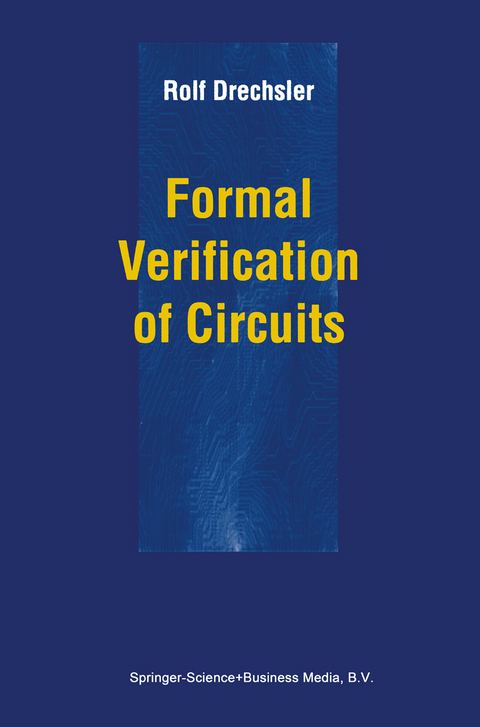
Formal Verification of Circuits
Seiten
2010
|
Softcover reprint of hardcover 1st ed. 2000
Springer-Verlag New York Inc.
978-1-4419-4985-1 (ISBN)
Springer-Verlag New York Inc.
978-1-4419-4985-1 (ISBN)
Formal verification has become one of the most important steps in circuit design. Applications to arithmetic circuit verification and verification of designs specified by hardware description languages are described to show how WLDDs work in practice.
Formal verification has become one of the most important steps in circuit design. Since circuits can contain several million transistors, verification of such large designs becomes more and more difficult. Pure simulation cannot guarantee the correct behavior and exhaustive simulation is often impossible. However, many designs, like ALUs, have very regular structures that can be easily described at a higher level of abstraction. For example, describing (and verifying) an integer multiplier at the bit-level is very difficult, while the verification becomes easy when the outputs are grouped to build a bit-string. Recently, several approaches for formal circuit verification have been proposed that make use of these regularities. These approaches are based on Word-Level Decision Diagrams (WLDDs) which are graph-based representations of functions (similar to BDDs) that allow for the representation of functions with a Boolean range and an integer domain.
Formal Verification of Circuits is devoted to the discussion of recent developments in the field of decision diagram-based formal verification. Firstly, different types of decision diagrams (including WLDDs) are introduced and theoretical properties are discussed that give further insight into the data structure. Secondly, implementation and minimization concepts are presented. Applications to arithmetic circuit verification and verification of designs specified by hardware description languages are described to show how WLDDs work in practice.
Formal Verification of Circuits is intended for CAD developers and researchers as well as designers using modern verification tools. It will help people working with formal verification (in industry or academia) to keep informed about recent developments in this area.
Formal verification has become one of the most important steps in circuit design. Since circuits can contain several million transistors, verification of such large designs becomes more and more difficult. Pure simulation cannot guarantee the correct behavior and exhaustive simulation is often impossible. However, many designs, like ALUs, have very regular structures that can be easily described at a higher level of abstraction. For example, describing (and verifying) an integer multiplier at the bit-level is very difficult, while the verification becomes easy when the outputs are grouped to build a bit-string. Recently, several approaches for formal circuit verification have been proposed that make use of these regularities. These approaches are based on Word-Level Decision Diagrams (WLDDs) which are graph-based representations of functions (similar to BDDs) that allow for the representation of functions with a Boolean range and an integer domain.
Formal Verification of Circuits is devoted to the discussion of recent developments in the field of decision diagram-based formal verification. Firstly, different types of decision diagrams (including WLDDs) are introduced and theoretical properties are discussed that give further insight into the data structure. Secondly, implementation and minimization concepts are presented. Applications to arithmetic circuit verification and verification of designs specified by hardware description languages are described to show how WLDDs work in practice.
Formal Verification of Circuits is intended for CAD developers and researchers as well as designers using modern verification tools. It will help people working with formal verification (in industry or academia) to keep informed about recent developments in this area.
1 Introduction.- 2 Notations and Definitions.- 3 Decision Diagrams.- 4 Theoretical Aspects of WLDDs.- 5 Implementation of WLDDs.- 6 Minimization of DDs.- 7 Arithmetic Circuits.- 8 Verification of Hdls.- 9 Conclusions.- References.
| Erscheint lt. Verlag | 2.12.2010 |
|---|---|
| Zusatzinfo | X, 179 p. |
| Verlagsort | New York, NY |
| Sprache | englisch |
| Maße | 155 x 235 mm |
| Themenwelt | Mathematik / Informatik ► Informatik ► Software Entwicklung |
| Informatik ► Theorie / Studium ► Künstliche Intelligenz / Robotik | |
| Informatik ► Weitere Themen ► CAD-Programme | |
| Informatik ► Weitere Themen ► Hardware | |
| Technik ► Elektrotechnik / Energietechnik | |
| ISBN-10 | 1-4419-4985-2 / 1441949852 |
| ISBN-13 | 978-1-4419-4985-1 / 9781441949851 |
| Zustand | Neuware |
| Haben Sie eine Frage zum Produkt? |
Mehr entdecken
aus dem Bereich
aus dem Bereich
Buch | Softcover (2024)
REDLINE (Verlag)
20,00 €
Eine kurze Geschichte der Informationsnetzwerke von der Steinzeit bis …
Buch | Hardcover (2024)
Penguin (Verlag)
28,00 €


